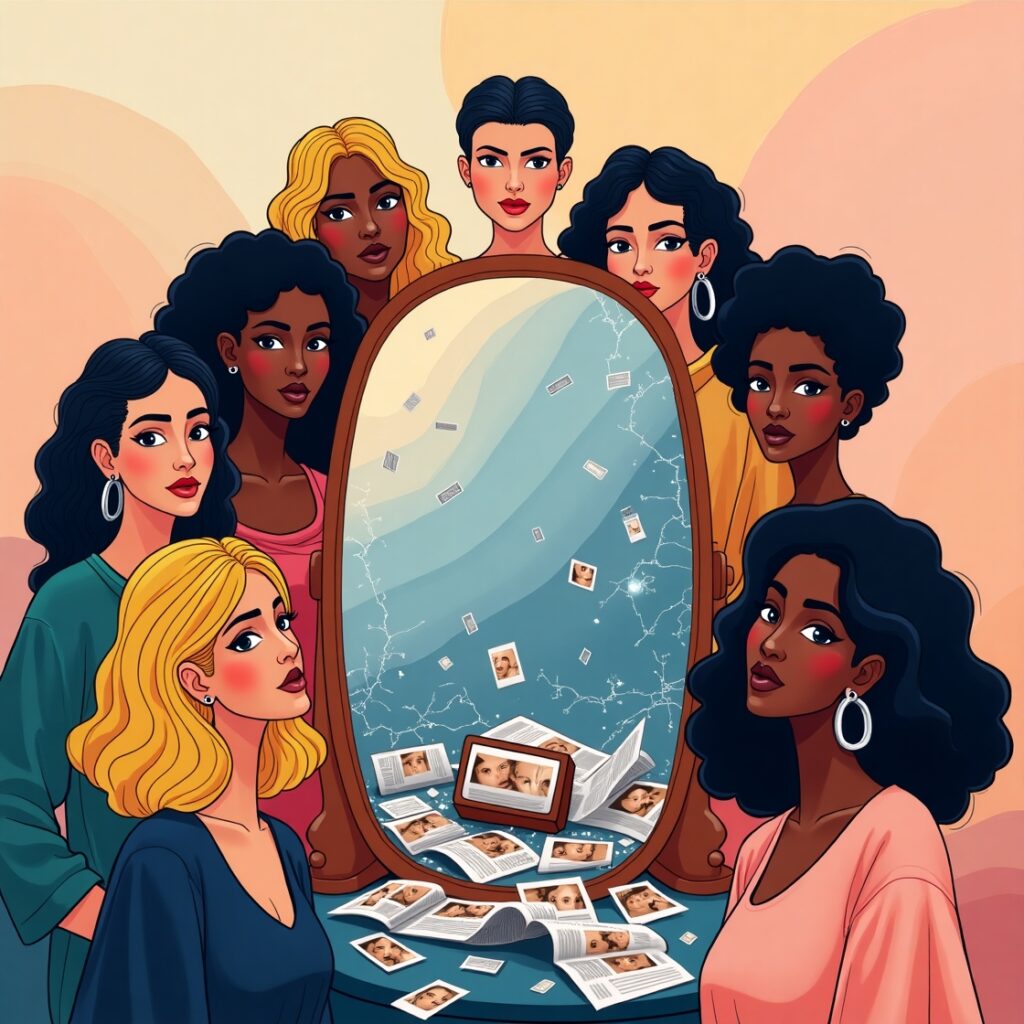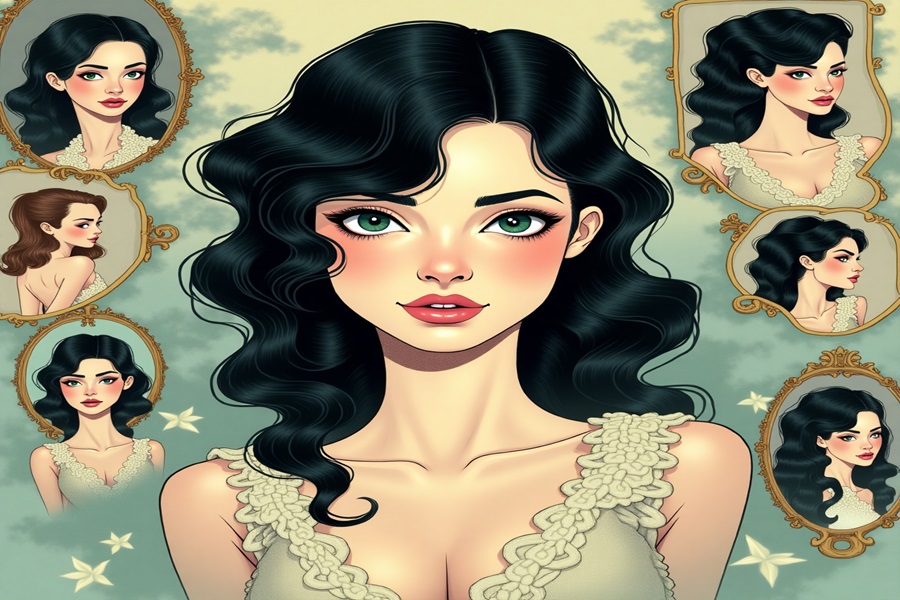How Beauty is Portrayed In Media let me tell youTelevision and movies have traditionally affected how people see their own beauty and that of those around them. No matter if it’s a magazine photo or an image on social media, the media carefully guides people about what beauty means. At times, these images express things society prefers, yet they also contribute to unrealistic expectations, connecting media to personal sense of self.
It covers the ways beauty is displayed in books, in films and online, as well as its evolution, what it does to our minds and culture and efforts by new voices to introduce fairer beauty standards.
The Role of Media In Beauty
Traditional or modern forms of media both show us a reflection and shape us. It shows the preferred ideas of beauty but also helps shape and set new ones for society.
Key forms of Media that Portray Beauty:
- Television and Film
- Print Media (magazines, newspaper)
- Advertising
- Social Media (Instagram, TikTok, Youtube)
- Music Videos and Celebrity Culture
Historical Evolution of Media in Beauty
Every medium has its own style, but the message usually focuses on a set of narrow images: youthfulness, slim appearance, a clear complexion, equal face features and determined markers of race or gender.
1950s–1970s were the years of the Glamour Ideal
In the middle of the 20th century, the media promoted Hollywood’s luxurious side. Marilyn Monroe was a symbol of hourglass beauty and actors from the era were shown as tough and neat.
During the 1980s and 1990s, supermodels and thinness were a big trend
Cindy Crawford’s and Kate Moss’ fame made very thin bodies trendy for many years. In the 1990s, being thin and pale was fashionable and often gave women impossible goals to achieve.
This period was known as the Airbrushed Era.
During the 2000s, digital tools allowed for images to be edited and made to look perfect. Perfectly beautiful skin, a tiny waist and no signs of getting older were common features on magazine covers.
Social Media Rises with the Influence of Filters since 2010
Instagram and Snapchat have made it possible for beauty to be shared by all, but they’ve also added filters to it. Because of filters, editing options and retouching apps, everyday people tried to craft their own flawless imagery. Thanks to influencers, brands now promoted themselves by setting new beauty trends based on Instagram ratings and views.
Common Beauty Stereotypes in Media
Media has for a long time counted on common beauty models which may carry harmful messages.

The Thin Ideal
A lot of the women in the media highlighted for their looks are many pounds below the typical weight range. It further suggests that being thin indicates good looks and achievement.
Fair Skin Bias
Light skin is often considered more attractive globally, for example, in India, the Philippines and plenty of African countries, mainly because of colonial and western media influences.
Youth Obsession
There are not enough older people involved, while anti-aging products receive a lot of attention. Wrinkles, greying hair and aging marks are seen as something to fix or mask.
Eurocentric Features
The main features shown in beauty images are narrow noses, full lips (yet not entirely full) and eyes that are usually light. These features often replace the variety that other races and ethnicities have.
Perfect Hair and Skin
Many beauty websites and advertising try to make voluminous hair and clear skin the usual, thanks to makeup and image editing.
Psychological Impact of Media Portrayals of Beauty
Exposure to many unrealistic photos on social media negatively affects mental health, mainly for those who are still young.
1. Body Dysmorphia
If individuals compare themselves to edited or filtered pictures, they can start to view their looks very differently.
2. Low Self-Esteem
Unable to look just like the celebrities in magazines or TV ads, people can feel less confident and valued.
3. Eating Disorders
Some studies have linked believing in unrealistic thinness as normal to both anorexia and bulimia.
4. Social Anxiety
Feeling pressure to be perfect on Instagram causes people to compare themselves socially, feel anxious and worry about what others will think.
Gendered Portrayals of Beauty
Women:
Women are regularly told that they should aim to look young, slim and blemish-free. The media often links a woman’s beauty to how valuable, successful and liked she is. Women in the media are often depicted in ways that make their appearance their top importance.
Men:
Information on male beauty isn’t often discussed, but it adheres to the same set of rules. Media mostly portrays men who are tall, muscular and well kept. An expression or departure from typical male behavior is often frowned upon or ignored.
Cultural Difference in Media Beauty Standards
Global acceptance of Western ideals does not stop Asian beauty from being unique:
- South Korea: Because of the emphasis on fair skin, slender lower face and large eyes, South Korea’s plastic surgery industry is very successful.
- India: In India, thin and tall models are still prized over body positivity which is just beginning to be embraced.
- Africa: People in the West might see certain features as ideal, but Africa is seeing pride in not just straight hair and a fair skin make more common.
- Latin America: Latinos appreciate a curvier body shape, but media usually aims to feature lighter skin.
Media vs. Reality: The Editing Trap
A significant portion of beauty media content is altered through:
- Photoshop
- Facetune and similar apps
- AI-generated enhancements
- Filters on Social platforms
Once the edited one is shown, the original seems less attractive by comparison. When media shows untrue images of people, many start to believe there is a need for perfection.
Positive Shifts in Media Beauty Standards:
Despite its weaknesses, the media is undergoing change. Due to what people want and the activism of many, more realistic and inclusive stories are becoming visible.
1. Body fashion Positivity and Neutrality are Unmoving Movements
Dove’s “Real Beauty” and many other plus-size modeling campaigns disagree with the notion that only thin bodies look attractive.
2. Diversity and having characters that look like us matter.
Models from various racial, sized, aged and gender backgrounds are now hired by brands. People credit Rihanna’s Fenty Beauty with transforming the makeup industry by including 50+ foundation shades for every skin color.
3. Public Voices from Celebrities
Lizzo, Jameela Jamil and Billie Eilish bring attention to using realistic beauty standards and looking after mental health.
4. Unfiltered Movements
Certain influencers on TikTok use this platform to show themselves without using makeup or filters. The tags nofilter and skinpositivity are gaining popularity recently.
The Role of Influencer and User-generated Media
It is now influencers, more than traditional celebrities, who are setting the standards for beauty. There are clear advantages and disadvantages to this change.
Positive:
- When more people create, more types of people are included in
- Unfiltered content is something you will find from many small
- People watching feel closer to the actors and
Negative:
- Even today, influencers use filters and
- Ads that are paid for can sometimes be
- Manipulated lifestyles on social media have made comparison culture very wide-
Media Literacy: A Tool for Critical Awareness
This can be controlled by having media literacy. It consists of showing people how to critically review what they watch in media.
Media Literacy Skills:
- The ability to examine and use media
- Most magazine and newspaper publications use content that is edited
- Recognizing the commercial side of the company
- Rejecting the idea that we have to match impossible goals
- Supporting various forms of beauty
All these groups—schools, parents and social media—have a role to play in encouraging media healthiness.
Conclusion:
The way beauty is featured in media can greatly affect both our view of self and our view of others. The industry has often pushed unrealistic and restricted expectations, but now there is an increasing move toward embracing everyone.
The journey is far from over, but with conscious media consumption, increasing representation, and continued advocacy, we can reshape how beauty is portrayed in media—for the better. By embracing all forms of beauty and rejecting harmful stereotypes, the media can become a powerful force for positive self-image and cultural acceptance.
